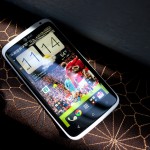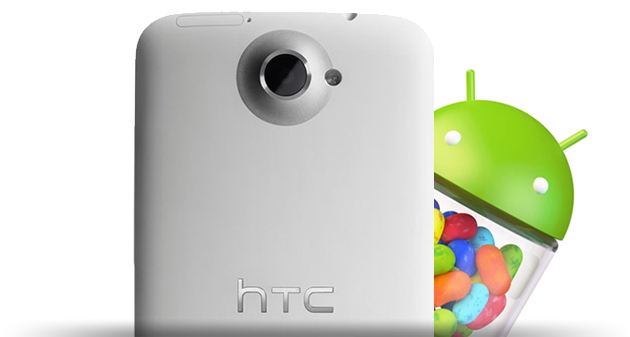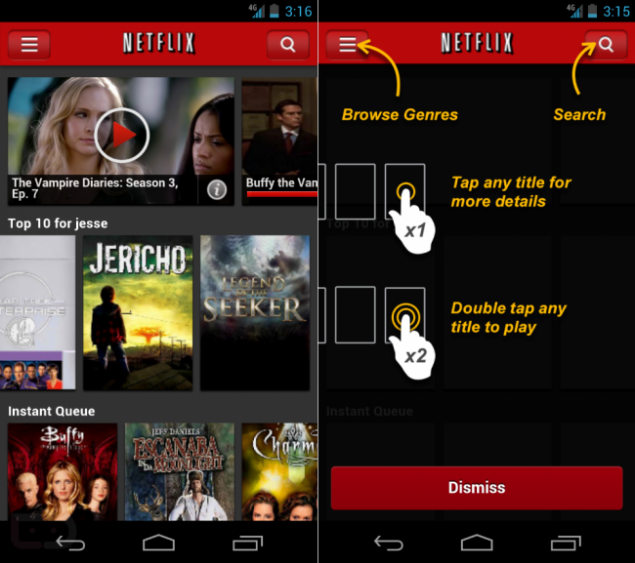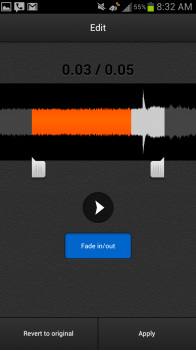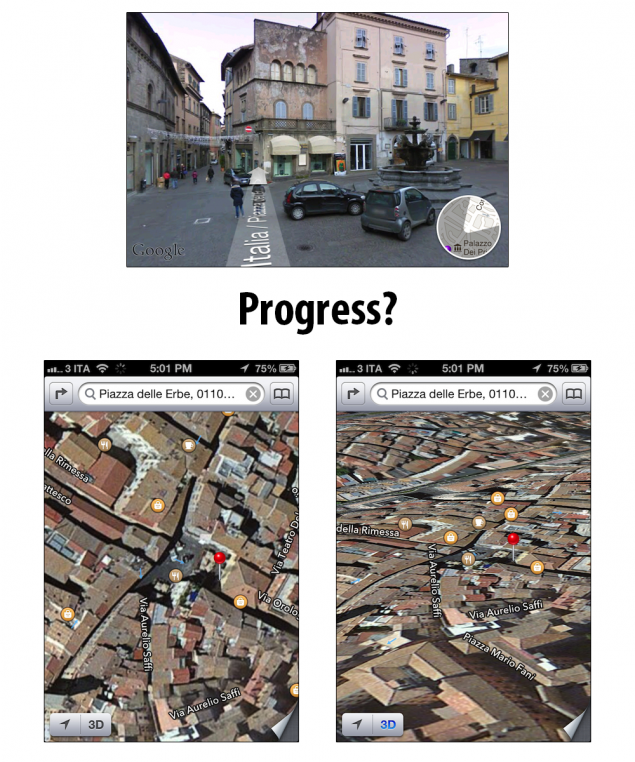Android Authority |
- Patent troll hits Google and Apple with a big fat patent infringement claim
- Facebook mobile apps to be refreshed on a 1-2 month basis
- Apple is in trouble for copying Switzerland’s famous railway clock
- NexPhone, an Ubuntu version of the ASUS Padfone and Moto Atrix
- Google Maps and Apple iOS 6: Here’s everything we know thus far
- Sprint Galaxy Note 2 handled in the wild: no release date, pricing or weird branding present
- IFTTT to stop supporting Twitter triggers on September 27th
- iOS 6 vs Jelly Bean, a tale of two updates
- Amazon Kindles are no longer available for purchase from your local Wal-Mart
- CIRP provides smartphone market share through the eyes of the carriers
| Patent troll hits Google and Apple with a big fat patent infringement claim Posted: 21 Sep 2012 02:34 AM PDT
Unwired Planet has filed patent infringement claims against Google and Apple. Both companies are charged with infringing on ten patents, but is seems likely that more claims might follow. The "intellectual property" company is claiming that Apple infringes on ten patents relating to its mobile devices, content systems, messaging, and maps (iPhone, iPad, iPod, iTunes, App Store, Apple Apps, Siri, Apple Push Notification Service, Apple Maps, Local Search, iAds, Safari web browser, Find My iPhone, Find My iPad, and Find My Friends) . Google is also charged with infringing on ten patents relating to its mobile devices, search and advertising, content systems, messaging, maps, and short-range radio communications (Motorola and Nexus mobile phones and tablets running Android, Google Search, Google AdWords, Google Places, Google Mobile Ads, Google Play, Google Apps, Bouncer, C2DM, GCM, Android Location, Google Maps, Google Street View, Google Latitude, Google My Location, Google+, Google+Local, Google Wallet). This is a wide ranging attack on both company's devices and services. The Unwired Planet CEO, Mike Mulica, said in the press release:
Unwired Planet was previously known as Openwave, Software.com, Phone.com, and it started life as Libris, Inc. Mulica describes it as:
In other words it is a patent troll. He went on to say:
So this troll is angry and on the warpath. It actually filed a case last year before the ITC attacking Apple and RIM over four other patents. This gives Apple and Google a common enemy so can we expect them to join forces? You can bet they are weighing up the seriousness of these claims and maybe even considering an acquisition rather than a court battle. If one of them snapped up the Unwired Planet portfolio it would presumably give them a considerable arsenal to use in the ongoing patent war. Related PostsApple Hits HTC Anew with Fresh Infringement Case, ITC: HTC can't use Google patents in legal fight against Apple, Google Nexus 7 to be included in patent infringement wars targeting Android?This article, Patent troll hits Google and Apple with a big fat patent infringement claim , was originally published at AndroidAuthority.com - Your Android News Source. |
| Facebook mobile apps to be refreshed on a 1-2 month basis Posted: 21 Sep 2012 02:19 AM PDT  We’re friends, aren’t we? So you say the Facebook app sucks? You said you don’t like Timeline’s look on your mobile browser? Then you’ll enjoy the news straight from Menlo Park, a promise of epic proportions, that Facebook will be updating its entire armada of mobile apps every 4-8 weeks. The reasoning behind this new strategy straight from the source:
In laymen’s terms: better, faster, harder, stronger. It used to be the case, Facebook would only “ship out” releases to their mobile apps when an itemized bunch of goodies was ready. Facebook noticed a repetitive problem with this assembly line technique. They quipped,”We'd decide on a bundle of features, furiously work on them, test them, and ship. Great updates we had already finished sometimes took longer to get into people's hands because we often had to wait for additions and tweaks that threw us off schedule." Now the mantra seems to be to combine efforts into bettering the mobile experience, as it has been over time with its Web interface. Recently, the company has been spinning out two updates a day for that version. Unfortunately, the resource-intensive task of doing the same for mobile apps is not in the task list for the social media giant. That’s fine by us: today’s Facebook for Android update was available for screens worldwide a measly 4 weeks after the last version was unveiled. Not bad, Mark. Not bad. What is your take on the Facebook promise? Do you think they can hold to it long-term? Will it change your usage of the mobile app, knowing it may get better with time? Related PostsFacebook App Center launched – new app store for Android and iOS apps, Facebook mobile app to get Instagram-like picture treatment, Facebook Taps HTC for Facebook-centric Android PhoneThis article, Facebook mobile apps to be refreshed on a 1-2 month basis , was originally published at AndroidAuthority.com - Your Android News Source. |
| Apple is in trouble for copying Switzerland’s famous railway clock Posted: 21 Sep 2012 01:50 AM PDT
Hans Hilfiker, an engineer, designed a clock face for the Swiss Federal Railways in 1955 that quickly became an internationally recognized symbol for his native country. Apple, with Wednesday’s release of iOS 6, used Hilfiker’s design as the icon for the clock application in the iPad. According to the Swiss site Blick.ch, the SBB (Schweizerische Bundesbahnen; aka Swiss Federal Railways) is “angry”. One of their spokespeople told the site that they’re trying to get in touch with Apple to discuss the financial and legal implications of the unauthorized use of their design. That’s all we know about the story thus far. So let’s count the number of things Apple screwed up in iOS 6: One, they pulled out YouTube, but that’s OK since Google launched a YouTube iOS app. Two, they pulled out Google Maps, which is making everyone upset because the new maps in iOS 6 are not only ugly, but they’re inaccurate too, which makes them doubly useless. Third, this whole clock thing. For a software release that’s been out for less than 48 hours, we’re curious to see how many more controversies occur. Should we all be furious at Apple? Normally we’d say no, that it’s OK for companies to compete because that drives society as a whole towards a better future, but this is different. Apple sues damn near everyone who uses Android, going in so far as to have devices taken off markets in certain countries, and now they’re blatantly copying a design that’s synonymous with an entire country. What’s worse? Is there anything good about this story? Potentially yes, if you’re in Switzerland that is. Apple will likely pay the SBB some money, and hopefully that money ends up being spent on upgrading trains, renovating some of the older railway stations, and other such infrastructure related projects. Related PostsIs Apple Copying the Asus Eee Pad Transformer?, Apple Copying Android – Jealous Much?, Phil Shiller testimony: iPhone, iPad creation and customer surveys, Samsung copying skills and iPhone 5 design secrecyThis article, Apple is in trouble for copying Switzerland’s famous railway clock , was originally published at AndroidAuthority.com - Your Android News Source. |
| NexPhone, an Ubuntu version of the ASUS Padfone and Moto Atrix Posted: 21 Sep 2012 01:13 AM PDT
When Ubuntu first came onto the computing scene, very few people knew how popular it would get in just a short amount of time. Sounds similar to Android doesn’t it? Now the boundaries between smartphone, tablet and notebook are blurring even further, with the advent of ideas like the Ubuntu for Android NexPhone. A dockable phone has been a recent innovation spawned by the increasing need to minimize gadgetry, and simultaneously, always have access to data at one’s fingertips. This is where the ASUS Padfone, Motorola Atrix, and now Canonical NexPhone comes in. A tepid reception for the Atrix does not spell failure for the NexPhone, however. In the words of NexCrea, the driving force behind this device:
Sounds good to us! NexCrea is currently having a fundraiser over at Indiegogo and the campaign ends Nov. 14. Unfortunately, total funds raised amount to just under $3K. You would think that a device that can do all of the following would be a hit with the public:
If NexCrea pulls out of its current funding stalemate, the pricing looks to be about $149 for the NexTablet, $199 for the NexLaptop and NexMonitor, and finally, $499 for the NexPhone and associated NexDock that makes the transformative magic happen. Related PostsNo related posts. This article, NexPhone, an Ubuntu version of the ASUS Padfone and Moto Atrix , was originally published at AndroidAuthority.com - Your Android News Source. |
| Google Maps and Apple iOS 6: Here’s everything we know thus far Posted: 21 Sep 2012 01:07 AM PDT
When Apple showed the world the iPhone for the first time in early 2007, they invited Eric Schmidt on stage, who at the time was the CEO of Google, to say a few words about how both companies worked closely together to deliver an amazing experience. Fast forward five years and the world today is practically upside down. The first Android phone, the T-Mobile G1, launched more than a year after the first iPhone, but today Android dominates the smartphone market. Forget about the technical and aesthetic differences between iOS and Android, the main driver of Google’s success with their mobile operating system has been its flexibility. If a company wants to make a $150 Android smartphone, then so be it. They can also make a $750 “phablet” if they want; the sky’s the limit. That, compared to Apple’s one phone every year business model, is why you see more devices running Android out there than you see iPhones. Now Apple, looking to get back at Google for making Android, has not only taken several Android handset makers to court, but with the latest release of their software platform, iOS 6, they stripped out two key Google apps: YouTube and Maps. Google already has a YouTube app in Apple’s App Store, and it’s the number one free download, but Maps is where things get complicated and nasty. Some people say Google has already made an iOS version of Google Maps and that it’s just waiting to be approved. Other’s say that’s not the case. Where’s not going to support either rumor, but we do want point out that Google releasing an iOS Google Maps app is all but guaranteed at this point. Why is Google Maps important? Because the maps that Apple put it in iOS 6 are terrible. They not only look worse than Google Maps, but they’re frighteningly inaccurate. Google, being a services company that monetizes their operation using targeted advertising, will, without a shadow of doubt, release Google Maps for iOS. The question is when? And that’s all we know about about this hullabaloo at the moment. Related PostsApple iOS 6 Maps a big disappointment. Will Apple approve Google’s new Maps submission soon?, Google releases update to Maps just as Apple rolls out iOS 6, Google Earth 7.0 update brings 3D maps, Maps update brings offline mapsThis article, Google Maps and Apple iOS 6: Here’s everything we know thus far , was originally published at AndroidAuthority.com - Your Android News Source. |
| Sprint Galaxy Note 2 handled in the wild: no release date, pricing or weird branding present Posted: 21 Sep 2012 12:38 AM PDT
A few days ago Samsung confirmed that five carriers in the U.S. will have the Galaxy Note 2 in stock by mid-November including Verizon, AT&T, Sprint, T-Mobile and U.S. Cellular. Of those five, Sprint and U.S. Cellular already announced the device, with the latter ready to take pre-orders for the phablet at $299.99 with new two-year contracts. But neither operator mentioned precise release dates for the device, with Sprint expecting to have the device in stores this fall and U.S. Cellular offering a "late October" launch window. Sprint went ahead and scheduled a press event in New York City where those attending were actually shown the device, and allowed to play with it. Engadget reports that Sprint's version is pretty much similar with the international Galaxy Note 2 that we've seen, in person, at IFA 2012 in late August. More importantly, Sprint's unit did not come with any weird branding, and by that we do mean it hasn’t adorned the Home button with the carrier's logo, a branding option revealed by a questionable Verizon Galaxy Note 2 leak recently. Moreover, there's no Sprint branding on the back of the phone either, although that could change by the time the handset is launched. Ultimately, this shouldn't be a buying impediment for anyone interested in a Galaxy Note 2 from the carrier. As for a clear release date and pricing details for Sprint's first Samsung phablet, carrier representatives were not able to provide an actual answer. They did say the device will come "this holiday season," without even mentioning the month, or what it will cost. While you wait for the device to launch with your favorite U.S. carrier – as long as it's one of the five mentioned above – we'll remind you that you can still register for our Galaxy Note 2 giveaway and win your phablet long before it launches in America. Related PostsSprint Galaxy Note 2 reportedly spotted as the Samsung SPH-L900, release date unavailable, AT&T Galaxy Note 2 release date set for October 21?, Verizon Galaxy Note 2 spotted, release date not available; U.S. Cellular to get it tooThis article, Sprint Galaxy Note 2 handled in the wild: no release date, pricing or weird branding present , was originally published at AndroidAuthority.com - Your Android News Source. |
| IFTTT to stop supporting Twitter triggers on September 27th Posted: 20 Sep 2012 11:53 PM PDT
IFTTT, which stands for “if this then that“, is an awesome online service that lets you build little scripts. Say for example you’re using Last.fm and an awesome song comes on. You click the like button and with IFTTT you can program it to automatically tweet out the track you just liked, post that track to Tumblr, share it to Evernote, and so on and so forth. IFTTT calls these little scripts “recipes”, and the community is more than eager to share what they’ve come up with so you can get the most out of the service. If you love Android because it lets you tweak just about everything in the operating system, you’re going to fall head over heels with IFTTT and all the things it can let you do. Now Twitter, in an effort to make more money, is discouraging people from using their API. They told IFTTT that they can no longer give their customers Twitter “triggers”. What’s a trigger? Say you setup IFTTT to send you an email anytime your favorite band sends out a tweet that has the name of your city in it. That tweet, with that keyboard, “triggered” IFTTT to do something. Starting September 27th, you’ll no longer be able to do things like that. If you want to tell IFTTT to send out a tweet on your behalf, then that’s cool. Twitter doesn’t have a problem with IFTTT sending tweets. Twitter just doesn’t want IFTTT to be constantly hitting their servers, waiting for specific tweets so they can perform specific actions. We’re huge fans of IFTTT at Android Authority, so we’re deeply saddened by this, but at the same time we understand why this had to happen. Many, probably all, of the online services we use are free. The people who create and run those services have to figure out how to pay their employees. If it means they have to turn off certain features that are too cost prohibitive, well, that’s life. Related PostsTwitter Expanded Tweets improved, coming soon to Android and iPhone, Android Authority is finally on Twitter, Samsung Galaxy S to get Froyo update in SeptemberThis article, IFTTT to stop supporting Twitter triggers on September 27th , was originally published at AndroidAuthority.com - Your Android News Source. |
| iOS 6 vs Jelly Bean, a tale of two updates Posted: 20 Sep 2012 11:45 PM PDT
Yes, we know it's iPhone 5 and iOS 6 week this time of year, as Apple has released its sixth major mobile OS refresh a couple of days ago which was followed by the sixth iPhone launch – currently taking place in Asia and Australia and quickly spreading to Europe and the North America. But what we're strictly interested in today is the inevitable iOS 6 vs Jelly Bean update comparison when it comes to availability and adoption rate among existing consumers, which you know from the get go that it’s not going to be a battle Google can win just yet. Cost and availabilityWhether you're updating your device to iOS 6 or Jelly Bean, you'll have to know that each update comes free of charge for no matter how many supported iOS and/or Android devices you own, as soon as either update is available. iOS 6 was demoed on stage during WWDC 2012 in June, and became available in beta version soon after that, with developers and non-developers being able to run those betas ever since. The OS has been presented one more time during the September 12 iPhone 5 event, and released to the public on September 19. Jelly Bean was also unveiled in June during the Google I/O event and shipped a few weeks later on Google's first tablet, the Nexus 7 that was running the OS right out of the box. Updates followed for other Nexus-branded devices, including the Google Nexus and the Nexus S, but they were not released as fast as one would have hoped for, especially for some U.S. versions of those phones. What you get and who is involvedWith iOS 6, you get mostly the same features for a variety of iOS devices, from iPhone 3GS to iPhone 5 – the list includes all iOS devices launched from iPhone 3GS to iPhone 5, except for the original iPad and iPod touch 3G (third-generation) – although there are some differences depending on what device you use and in which country.  Image Credit: Chitika Apple is the only company in control of pushing out the updates, with carriers left at the door watching the whole thing. Crapware on the devices is not available. With Jelly Bean, you also get the same features across supported devices. But unfortunately, in addition to Google who's in charge of directly updating Nexus-branded devices we also have OEMs and carriers having a say in the whole thing. OEMs are interested in applying their custom user interfaces on top of Android, while carriers want to add in various apps they think the users would want to have installed on the devices they purchase. That's why Jelly Bean updates are taking their time. As for the smartphones and tablets that are compatible with Android 4.1, one would expect to see all the devices that run Ice Cream Sandwich to get Jelly Bean as well. But that's not up to Google to decide. With Android, there's always the choice of going with Jelly Bean custom ROMs, thus getting the latest OS a lot faster and doing away with the carriers' influence. However, while we do have plenty of How To posts that show you how to install several custom ROMs on a variety of devices, we don't recommend you go for unofficial ROMs. That's entirely your call to make, especially if you're well-versed in Android customization.  Jelly Bean on Nexus S 4G (left) vs iOS 6 on iPhone 4S (right) | Image credit: ZDNet With both iOS 6 and Jelly Bean, you can expect existing apps to run on the iOS or Android device that's being updated immediately after performing the update, without expecting developers to release updates of their own for those apps. However, you'll notice that a variety of apps will be updated to make better use of the features of the latest mobile OS available. And that's probably especially true with iOS apps for the new iPhone 5 and fifth-generation iPod touch, as both devices come with a larger 4-inch display. As for future iOS devices, it’s safe to say all upcoming Apple mobile gadgets will run the software out of the box – the list is probably limited to the iPad Mini (rumored to launch later this year) and iPad (fourth generation that’s coming next year). What’s annoying for the Android ecosystem is that devices still launch with Ice Cream Sandwich on board (if not an even earlier version for certain devices) despite the fact that Jelly Bean has been available to OEMs for a few months – and yes, Motorola, we’re mostly looking at you right now. A tale of two updatesA story on the matter featured on ZDNet comes just in the nick of time, comparing the update process to the latest mobile OS for either platform for two handsets, the iPhone 4S and the Nexus S 4G. James Kendrick writes:
According to Kendrick, he was able to perform the updates at the same day on those two devices, and the winner was the iPhone 4S:
Meanwhile, the Jelly Bean update for the Nexus S 4G – which arrived a lot later than expected for the second-generation Nexus handset – "started off nicely" but was soon hit by Google Play bugs and issues communicating with Google's servers.
Market shareA new Chitika report reveals that 15% of eligible iOS devices have been updated to iOS 6 on the first day, compared to Jelly Bean "which only saw a 1.5% adoption rate within its first two months." Comparatively, it took iOS 5 three days to reach the same market share, and since we're talking about previous-generation mobile OS version, we'll also note that some Android devices are just getting the Ice Cream Sandwich update they deserve, with ICS currently found on around 20% of Android devices. Now, without actually trying to figure out how many devices are compatible with iOS 6 or Jelly Bean, we will say that there are over 400 million iOS devices out there and over 500 million Android devices. So that 15% share is quite impressive for a first day update.  Image Credit: Sandvine
Another report from Sandvine goes to show that the iOS 6 update generated in a spike of traffic for Apple's iTunes stores – App Store and Mac App Store. In addition to the iOS 6 update, Apple also released a Mac OS X 10.8.2 update, while various developers have already optimized their apps for iOS 6. Venturebeat said about these traffic spikes:
As for Jelly Bean, Google is less likely to experience similar spikes in Google Play traffic because of the way the Android updates are handled. We can only imagine that in case Google would have a stronger say in the way updates are performed, traffic to its own stores would increase at least during the updates and immediately after, which could lead to an increased number of digital content sales. A foregone conclusioniOS 6 beats Jelly Bean when it comes to update availability and adoption from existing user base and there's no way around it – again, we’re not looking today at iOS 6 vs Jelly Bean features. In fact, we can already say that iOS 7 will beat Key Lime Pie, or whatever the latest Android OS version will be when iOS 7 rolls out in 2013, because that's the nature of these two major mobile platforms that dominate the smartphone ecosystem, at least right now. Naturally, Android fans can only hope that more Nexus-branded devices will be released in the near future, especially considering the various rumors that have recently mentioned the potential launch of a Samsung Galaxy Nexus 2, an LG Optimus Nexus and a Sony Xperia Nexus. And don't even get me started on the recently announced RAZRs that don't run Jelly Bean out of the box – it's not like Google paid a tremendous amount of money to buy the company in order to focus more on hardware. Or was it patents? What OS are you running on your mobile device? Related PostsNo related posts. This article, iOS 6 vs Jelly Bean, a tale of two updates , was originally published at AndroidAuthority.com - Your Android News Source. |
| Amazon Kindles are no longer available for purchase from your local Wal-Mart Posted: 20 Sep 2012 11:19 PM PDT
Wal-Mart, America’s largest supermarket chain that sells damn near everything at prices so low you start to wonder how people in China survive, has decided to stop selling Amazon’s various Kindle devices in their stores. Why? Because Amazon, when you stop and think about it, is basically Wal-Mart, but in the cloud. Both Wal-Mart and Amazon will sell you pretty much everything your little heart desires. They’re both incredibly price competitive. And they both have very well known brands. So why then would Wal-Mart sell you Amazon’s devices when Amazon’s devices are nothing but a gateway to Amazon’s massive online store? It’s just bad business. Put yourself in Wal-Mart’s shoes. Do you want to sell a product that encourages people to do their shopping from the comfort of their homes instead of your brick and mortar stores? Absolutely not. Target, another chain that’s often billed as the “upscale” version of Wal-Mart, recently decided to stop selling Amazon’s Kindles as well. Will these decisions have an impact on the Android tablet ecosystem? First of all, what Android tablet ecosystem? A Kindle may run Android, but it’s not really the same version of Android we all know and love. And as for tablets from the likes of Samsung, ASUS, and other companies … they haven’t exactly been doing all that well. Besides, Wal-Mart and Target customers usually live in suburbs, which means they have cars, so there’s a high probability that they live next to an electronics store. They’ll have to go to two stores instead of one if they want a Kindle, but really, is that such a bad thing? If someone really wants a tablet, they’ll figure out how to buy it. It’s as simple as that. Related PostsAmazon Ad: Three Kindles Still Cost Less than an iPad, In-apps purchase finally coming to the Amazon Appstore, Amazon’s Appstore reaches new 50,000 app milestoneThis article, Amazon Kindles are no longer available for purchase from your local Wal-Mart , was originally published at AndroidAuthority.com - Your Android News Source. |
| CIRP provides smartphone market share through the eyes of the carriers Posted: 20 Sep 2012 09:24 PM PDT
When looking at the current market share of smartphones, we commonly look at manufacturers and operating systems. However, what do the smartphone sales of each individual carrier look like? The Consumer Intelligence Research Partners (CIRP) have provided us with exactly that information. The results paint a very interesting picture. Android will sit on top taking the crown as it outsells all other devices on 3 out of the 4 major carriers. However, when looking at AT&T's statistics, there have been more iPhone activations than Android activations. The most logical explanation for this is that AT&T was the first carrier to carry the iPhone, so I'm sure a lot of people never saw any reason to switch. However, it is still very surprising given the recent AT&T order to push non-iPhone devices. In addition, Verizon has been supporting Android longer than any other carrier since the introduction of their DROID line. It is no secret that Verizon has been favoring Android over iOS as well.
The data collected by CIRP also showed that the majority of Verizon's phone sales occurred in their retail stores. This is far different from the case with the other three major carriers. As a matter of fact, 25% of all smartphone sales took place right in a Verizon Wireless store. That might mean that Verizon's sales representatives are actually doing their jobs, or maybe it just means that Verizon stores are more convenient than its online services. Whatever the reason may be, it is certainly shocking considering the explosion of online purchases in the past couple of years. The final piece of information revealed is somewhat embarrassing for Blackberry and Windows based devices. Basic phones outsold both Windows and Blackberry devices combined. This is certainly not a good sign. Luckily, there are reportedly big things coming in the future for both Windows Phone and Blackberry. Related PostsAndroid Smartphone Market Share Declines for the First Time, Android Still Tops iOS in U.S. Smartphone Market Share and Data Usage, Android takes control of 25% of the global smartphone market shareThis article, CIRP provides smartphone market share through the eyes of the carriers , was originally published at AndroidAuthority.com - Your Android News Source. |
| You are subscribed to email updates from Android Authority To stop receiving these emails, you may unsubscribe now. | Email delivery powered by Google |
| Google Inc., 20 West Kinzie, Chicago IL USA 60610 | |














